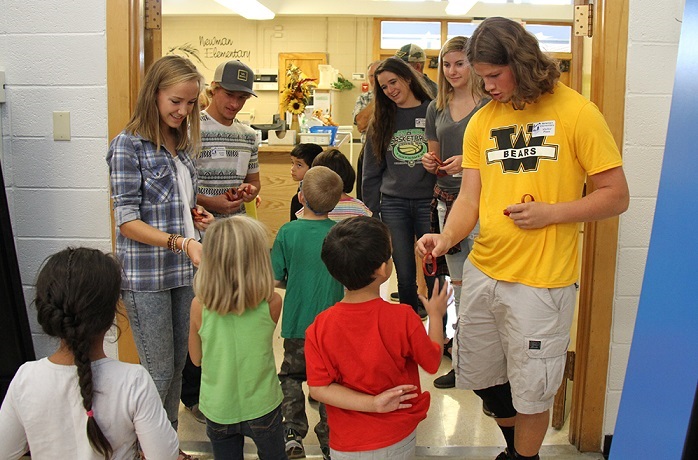
Caitlin Copple, Montana-Idaho-Wyoming Correspondent
Since 2009, the Dennis & Phyllis Washington Foundation has granted $900,000 to help Graduation Matters Montana increase graduation rates in 53 communities. After the initial grant of $450,000 in 2009, the family foundation has helped the state has reached an all-time high of 86% of students graduating, cutting the drop-out rate by more than a third.
Now in its fifth year, the Graduation Matters recipe for success is focused on family involvement and community partnerships.
“We have found in everything we do, if you don’t have strong parent involvement from the get-go, your chances of success are reduced considerably,” explained Mike Halligan, Dennis & Phyllis Washington Foundation executive director. “If mom or dad don’t think this important, it won’t work. If homework isn’t getting done, you need to be able to call them, talk about the issues confronting the student and family, and figure out a plan to work together to help.”
Local control is also key, he added — involving schools, businesses and nonprofits, teachers and administration, and above all else, students and their families.
Last time Philanthropy Northwest’s annual conference took place Missoula, in 2011, local school district officials held a session on Graduation Matters, then in its infancy. With our annual conference returning to Missoula in September, including Halligan as one of our co-chairs, the Dennis & Phyllis Washington Foundation looks forward to updating our six-state region's funders on what's possible through community collaboration — adding fuel to the ballooning interest in this place-based giving model.
“We had no idea this would explode to the extent that it has,” Halligan said. “We got very lucky in that we had a local control model to build from that OPI [Office of Public Instruction] and local school districts embraced. Having a proven model to implement the Graduation Matters program helped shoulder the leadership burden and then the only issue was providing grant funds to support implementation."

In addition to support from the Dennis & Phyllis Washington Foundation, Halligan has recruited colleagues from Burlington Northern Santa Fe Railroad, AT&T, First Interstate Bank and Steele Reese Foundation to bring in $1.3 million in total foundation and corporate giving to Graduation Matters.
"We are proud to support this statewide effort that has such a great impact on Montana," said Kelly Bruggeman, executive director of the First Interstate BancSystem Foundation, a Philanthropy Northwest member organization. "Not only have we been able to provide some financial support, but our employees volunteer with the local efforts in their communities, too."
Smaller donations are also welcomed by Graduation Matters schools, to cover things like assembly presentations and event refreshments
Projecting a Brighter Future
More than three quarters of Montana high school students now attend Graduation Matters schools. Halligan credits the explosion of interest to communities seeing firsthand how the program improves local economies. Superintendent of Public Instruction Denise Juneau said the Alliance for Excellent Education has projected graduates since 2009 will bring $6 million in economic activity to Montana.
"The combination of our financial resources and the statewide press about the Graduation Matters program was key, because schools are hungry for programming that comes with resources,” Halligan said. “For a Graduation Matters community to succeed, they need a proactive mindset to put the pieces in place to improve graduation rates.”
In a reservation community, that might look like involving tribal elders and extended families, he explained. According to the Graduation Matters 2015 Graduation and Dropout Report, 29% of Montana’s dropouts are American Indian, even though Native students only comprise 10% of the state’s public school population. While the rate among Native students lags behind, the dropout rate among this population has dropped by almost a third since 2008.
In a place like Bozeman or Missoula, kids could be most responsive to hearing directly from a CEO who is creating jobs in their town and who can give them examples of what it’s like to be in the workforce. Each school or school district can adapt the model to fit their particular needs.
“It’s been great to see it become a competition between schools to see who has the highest graduation rates,” Halligan said. “We can’t say that kids are our most important resource if we can’t make good on our promise to give them the tools they need to be successful in life.”
Thanks to community-driven partnerships and philanthropic leaders like the Dennis & Phyllis Washington Foundation, Montana is sticking to its commitment to kids. The foundation's grant will continue through 2017, with a new superintendent at the helm. (Juneau is term-limited and therefore can't seek re-election.) Republican or Democrat, Halligan says the funding will help ensure a smooth transition.
Read the Complete 2015 Graduation Matters Report
Caitlin Copple edits Philanthropy Northwest's quarterly Montana-Idaho-Wyoming E-Bulletin. To receive Philanthropy Northwest e-bulletins and other updates, sign up on our website.


